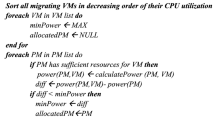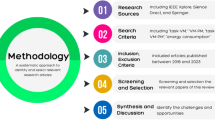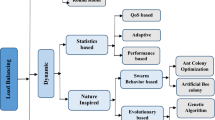Abstract
Attracting customers through reward programs is the primary key success for customer-oriented organizations. One of the most famous customer reward programs is applying price discount. In our negotiation-based cloud resource allocation problem, discount price is offered based on both status of a provider and behavior (or loyalty class) of a customer. That is, a resource customer who has appropriate buying behavior and negotiates for resource type instances with high necessity to sell is deserved to receive high price discount from provider. To do this, first, three customer’s loyalty classes are defined and customers are classified into theses classes in terms of their previous buying behavior using fuzzy system in name FCLCDS. Second, another fuzzy system in name FNTSVMTDS is designed to determine the value of necessity to sell resource type. The outputs of FCLCDS and FNTSVMTDS are called Loyalty Class (LC) and Necessity to Sell VM Type (NtSVMT), respectively. Finally, a fuzzy system in name FDCDS is proposed to determine the discount coefficient based on both LC and NtSVMT inputs. Furthermore, appropriate times for calculating/re-calculating the discount coefficients that are applied by a resource provider to relax its counter-offers are calculated. We perform extensive simulation experiments to compare our designed negotiator in name FDMDA with MDA and FNSSA. The results show that our designed FDMDA outperforms MDA and FNSSA.














Similar content being viewed by others
Notes
Counter-proposal is the proposal which is made in response to the received proposal from a trading opponent.
Typically three customer classes (or membership levels) called: “Gold”, “Silver” and “Bronze” are defined [10].
Amazon EC2 Instance Types. [Online]. Available: https://aws.amazon.com/ec2/instance-types/.
Each PDA determines the maximum price discount that can be applied for LC of type Gold (i.e., MaxDiscountGold), the maximum price discount that can be applied for LC of type Silver (i.e., MaxDiscountSilver) and the maximum price discount that can be applied for LC of type Bronze (i.e., MaxDiscountBronze) in a way that MaxDiscountGold> MaxDiscountSilver> MaxDiscountBronze..
References
Repschlaeger, J., Erek, K., Zarnekow, R.: Cloud computing adoption: an empirical study of customer preferences among start-up companies. Electron. Mark. 23, 115–148 (2013)
Zhang, Q., Zhu, Q., Boutaba, R.: Dynamic resource allocation for spot markets in cloud computing environments. In: Proceeding of the 4th IEEE International Conference on Utility and Cloud Computing, Melbourne. IEEE; pp. 178–185 (2011)
Buyya, R., Pandey, S., Vecchiola, C.: Market-Oriented Cloud Computing and the Cloudbus Toolkit. Wiley Press, New York (2011)
Li, J., Yahyapor, R.: A strategic negotiation model for grid scheduling. In: Cluster Computing and the Grid. CCGRD 06, pp. 574–583 (2006)
Sim, K.M.: Grid resource negotiation: survey and new directions. IEEE Trans. Syst. Man Cybern. Part C 40(3), 245–257 (2010)
Chen, J., Han, X., Jiang, G.: A negotiation model based on multi-agent system under cloud computing. The Ninth International Multi-Conference on Computing in the Global Information Technology (ICCGI 2014), pp. 157–214 (2014)
Sandholm, T.: Agents in electronic commerce: component technologies for automated negotiation and coalition formation. Auton. Agent. Multi-Agent Syst. 3(1), 73–96 (2000)
Sim, K.M.: Negotiation agents that make prudent compromises and are slightly flexible in reaching consensus. Comput. Intell. 20(4), 643–662 (2004)
EsmaeiliGookeh, M., Tarokh, M.J.: Customer lifetime value models: a literature survey. Int. J. Ind. Eng. Prod. Res. 24(4), 317–336 (2013)
Hederstierna, A., Sallberg, H.: Bronze, silver and gold: effective membership design in customer rewards programs. Electron. J. Inform. Syst. Eval. 12(1), 9–66 (2009)
Al-Roomi, M., Al-Ebrahim, Sh, Buqrais, S., Ahmad, I.: Cloud computing pricing models: a survey. Int. J. Grid Distrib. Comput. 6, 93–106 (2013)
Zhang, Z., Li, Z. Wu, C.: Optimal posted prices for online cloud resource allocation. In: 2017 ACM SIGMETRICS/International Conference on Measurement and Modeling of Computer Systems, Urbana-Champaign, https://doi.org/10.1145/3078505.3078529 (2017)
Toosi, A.N.: On the economics of infrastructure as a service cloud providers: pricing, markets, and profit maximization. Ph.D. Thesis, The University of Melbourne (2014)
Zaman, S., Grosu, D.: Combinatorial auction-based allocation of virtual machine instances in clouds. J. Parallel Distrib. Comput. 73(4), 495–508 (2013)
Samimi, P., Teimouri, Y., Mukhtar, M.: A combinatorial double auction resource allocation model in cloud computing. Inform. Sci. 357, 201–216 (2016)
Sim, K.M.: Grid commerce, market-driven G-negotiation, and grid resource management. IEEE Trans. Syst. Man Cybern. Part B 36, 1381–1394 (2006)
Sim, K.M.: Equilibria, prudent compromises, and the “Waiting” game. IEEE Trans. Syst. Man Cybern. Part B 35, 712–724 (2005)
Sim, K.M., Wang, S.Y.: Flexible negotiation agent with relaxed decision rules. IEEE Trans. Syst. Man Cybern. Part B 34(3), 1602–1608 (2004)
Sim, K.M., Ng, K.F.: Relaxed-criteria negotiation for grid resource allocation. Int. Trans. Syst. Sci. Appl. 3(2), 105–117 (2007)
Sim, K.M.: Evolving fuzzy rules for relaxed-criteria negotiation. IEEE Trans. Syst. Man Cybern. Part B (Cybernetics) 38(6), 1486–1500 (2008)
Adabi, S., Movaghar, A., Rahmani, A.M., Beigy, H.: Negotiation strategies considering market, time and behavior functions for resource allocation in computational grid. J. Supercomput. 66, 1350–1389 (2013)
Adabi, S., Movaghar, A., Rahmani, A.M., Beigy, H.: Market_based grid resource allocation using new negotiation model. J. Netw. Comput. Appl. 36, 543–565 (2013)
Adabi, S., Movaghar, A., Rahmani, A.M., Beigy, H.: A new fuzzy negotiation protocol for grid resource allocation. J. Netw. Comput. Appl. 37, 89–126 (2014)
Adabi, S., Adabi, S.: A BBO based procedure for evolving fuzzy rules of relaxed-criteria negotiation in grid resource allocation. IJCSI Int. J. Comput. Sci. 12(4), 17–35 (2015)
Sim, K.M.: Towards a unifying multilateral cloud negotiation strategy. In: Proceedings of the International Multi Conference of Engineers and Computer Scientists vol I, IMECS, pp. 13–15 (2013)
Sim, K.M.: Complex and concurrent negotiations for multiple interrelated e-markets. IEEE Trans. Cybern. 43(1), 230–245 (2013)
Javed, B., Bloodsworth, P., Rasool, R.U., Munir, K., Rana, O.: Cloud market maker: an Automated dynamic pricing marketplace for cloud users. Future Gener. Comput. Syst. 54, 52–67 (2016)
He, K., Huang, C., Li, Z., Shi, J., Shi, A.: An online auction for deadline-aware dynamic cloud resource provisioning. IEEE 22nd International conference on parallel and distributed systems (ICPADS), Wuhan, pp. 677–684 (2016)
Kumar Awasthi, S., Vij, S.R., Mukhopadhyay, D., Agrawal, A.J.: Multi-strategy based automated negotiation: BGP based architecture. International Conference on Computing, Communication and Automation (ICCCA), Noida, pp. 588–593 (2016)
Zhang, Y., Xu, K., Shi, X., Wang, Y.: Design, modeling, and analysis of online combinational double auction for mobile cloud computing markets. Int. J. Commun Syst 31(7), 34–60 (2018)
Adabi, S., Mosadeghi, M., Yazdani, S.: A real-world inspired multi-strategy based negotiating system for cloud service market. J. Cloud Comput. Adv. Syst. Appl. 7(17), 1–40 (2018)
Kand, A.S.Y., Kazem, A.A.P.: Combinational double auction winner determination in cloud computing using hybrid genetic and simulated annealing algorithm. Int. J. Adv. Comput. Sci. Appl. 9(1), 435–436 (2018)
Zhang, J., Xie, N., Zhang, X., Li, W.: An online auction mechanism for cloud computing resource allocation and pricing based on user evaluation and cost. Future Gener. Comput. Syst. 89, 286–299 (2018)
Bhan, R., Singh, A., Pamula, R., Faruki, P.: Auction based scheme for resource allotment in cloud computing. In: Patnaik, S., Yang, X.S., Tavana, M., Popentiu-Vlădicescu, F., Qiao, F. (eds.) Digital Business. Lecture Notes on Data Engineering and Communications Technologies, vol. 21. Springer, Cham (2019)
Baranwal, G., Kumar, D., Raza, Z., Vidyarthi, D.P.: A negotiation based dynamic pricing heuristic in cloud computing. Int. J. Grid Util. Comput. 9(1), 83–96 (2018)
Nejad, M.M., Mashayekhy, L., Grosu, D.: A family of truthful greedy mechanisms for dynamic virtual machine provisioning and allocation in clouds. In: Proceeding of the IEEE Sixth International Conference Cloud Computing, pp. 188–195 (2013)
Nadjaran Toosi, A., Van Mechelen, K., Buyya, R.: An auction mechanism for a cloud spot market. TAAS 11, 1–35 (2014)
Sim, K.M.: Agent-based cloud computing. IEEE Trans. Serv. Comput. 5(4), 564–577 (2012)
Sim, K.M., Ng. K.F.: A relaxed-criteria bargaining protocol for grid resource management. In: Proceedings of the Sixth IEEE International Symposium on Cluster Computing and the Grid Workshops (CCGRIDW’06), Singapore, vol. 2, pp. 8 (2006)
Ross, T.J.: Fuzzy Logic with Engineering Applications. McGraw-Hill, New York (1995)
Zalaghi, Z., Abbasnejad Varzi, Y.: Measuring customer loyalty using an extended RFM and clustering technique. Manag. Sci. Lett. 4, 905–912 (2018)
Ghaleb Magatef, S., Fakhri Tomalieh, E.: The impact of customer loyalty program on customer retention. Int. J. Bus. Soc. Sci. 6(8), 78–93 (2015)
Kervizic, J.: On customer lifetime value in ecommerce. Accessed 13 May 2019
Calheiros, R., Ranjan, R., Beloglazov, A., De Rose, C.A.F., Buyya, R.: CloudSim: a toolkit for modeling and simulation of cloud computing environments and evaluation of resource provisioning algorithms. Software: Practice and Experience (SPE), vol. 41, pp. 23–50. Wiley Press, New York (2011)
Zhang, L., Li, Z., Wu, C.: Dynamic Resource Provisioning in Cloud Computing: A Randomized Auction Approach, pp. 433–441. INFOCOM, Toronto (2014)
Author information
Authors and Affiliations
Corresponding author
Additional information
Publisher's Note
Springer Nature remains neutral with regard to jurisdictional claims in published maps and institutional affiliations.
Appendix: setting the values of MinDDTF and MaxDDTF
Appendix: setting the values of MinDDTF and MaxDDTF
Following, the process of determining the values of MinDDTF and MaxDDTF is discussed. Considering different value ranges of three classes of negotiation deadline in names Loose, Moderate and Tight (see Table 7), various market conditions are experienced. The value of MinDDTF should be determined in a way that safe and acceptable visit time is guaranteed under different market conditions. As the minimum value of a negotiator’s deadline is 20 (see Tight deadline values in Table 7), and consider the two facts: (1) any decision about making price discount is made between the half time of a negotiator’s deadline and negotiator’s deadline, and (2) provider agents make any decision in even rounds of the markets, MinDDTF should be selected from the set MinTF = {2, 4, 6, 8} to provide the possibility of making even market rounds between \( \frac{20}{2} \) (i.e., half of deadline) and 20 (i.e., deadline). In other words, by having ten market rounds between \( \frac{20}{2} \) and 20, the even market rounds in which any decision can be made are \( \left({\frac{20}{2} + 2} \right),\left({\frac{20}{2} + 4} \right),\left({\frac{20}{2} + 6} \right)\;{\text{and}}\;\left({\frac{20}{2} + 8} \right). \) This selection guarantees that the agents who have Tight deadlines are provided with the chance of applying price discount (if necessary) at least one time. In addition, the value of MaxDDTF should be determined in a way that all negotiators with different deadlines benefit from it. Thus, by having a negotiator agent who has the minimum time for renting resources (i.e., negotiator whose deadline value is equal to 20), and considering the two above mentioned facts in making price discount, the value of MaxDDTF should be selected from the set MaxTF = {4, 6, 8} to provide the possibility of making even market rounds between \( \frac{20}{2} \) (i.e., half of deadline) and 20 (i.e., deadline). Logically, in defining the MaxTF set, number 2 is not considered. That is because, any value of MaxDDTF should be greater than the minimum value of MinDDTF. Following, extensive amount of simulations was carried out considering the different feasible combinations from the MinTF and MaxTF sets. Then, the experimental results of these various combinations are reported to decide about the suitable values of MinDDTFand MaxDDTF. It is experimentally determined that MinDDTF = 4 and MaxDDTF = 8 give acceptable results in different market conditions. Obviously, determination of the more exact amounts of MinDDTF and MaxDDTF can be focused in future works through adopting a suitable learning technique.
Rights and permissions
About this article
Cite this article
Adabi, S., Hossein-Haje, Z. & Adabi, S. A new cost-effective mechanism for VM-to-user mapping in cloud data centers. Cluster Comput 23, 2425–2451 (2020). https://doi.org/10.1007/s10586-019-03017-w
Received:
Revised:
Accepted:
Published:
Issue Date:
DOI: https://doi.org/10.1007/s10586-019-03017-w




